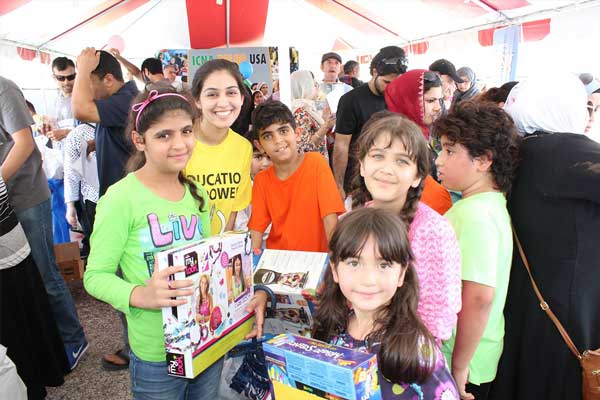“Ask them, ‘Who has forbidden the beauty of God which He has created for His servants and the things clean and pure for sustenance? They are made for the believers in this world and are exclusively for them on the Day of Judgment.’ Thus do We explain Our revelations to the people who have knowledge.” (Quran 7:32)
“God is Beautiful and He loves Beauty.” (Hadith, Sahih Muslim)
After a lecture to students and faculty at Princeton University, the Persian professor Dr. Aminah Mahallati approached me and said, “You stand where Einstein once stood and lectured.” I was amazed to hear that statement and it struck a chord in me. I do not possess Einstein’s brain power or his flamboyant hairdo. However, I am blessed with something valuable – Islamic art. Art has opened so many doors of opportunity for me from teaching art seminars at Ivy League schools to having my artwork featured in a Hollywood film.
My work as a visual artist finds a connection, identity, unity, and empathy with my fellow Americans. People are drawn to beauty and the decorative flourishes of calligraphy, symbolic motif of symmetrical arches, beautifully curved domes, and the captivating intricacy of geometrical patterns – all part of Islamic art – mesmerize people. In Islamic art, we have been blessed with a rich tradition that simply needs to be communicated to the masses.
Many cultures have preserved their identity and expressed their traditional narrative through art. Promoting Islamic art, so distinctive and celebrated in art history, presents a positive image of Islam and Muslims. I believe art can also offer so much to American Muslims’ efforts to enlarge their narrative in the world, to encompass more than grievance and suffering. Art facilitates conversation and breaks down barriers. American Muslims build mosques and schools, initiate social welfare programs, host interfaith seminars, and participate in the political arena. All of that is good and beneficial to the Muslim community and to the larger American community. We can add to that index of good works the use of Islamic art to affirm a positive identity and contribute to the beauty of this world. As mentioned above, “God is Beautiful and He loves beauty.”
Changing the Narrative Through Islamic Art
Some American Muslims might be skeptical about helping to change the narrative about Islam through Islamic art. But the benefits are clear, including the following:
Identity – Islamic art is a visual representation of the majesty and beauty of Islam, with its sense of order, proportion, symmetry, and mystic presence.
Diversity – Islamic art is not a monolithic medium. It encompasses the diversity of people, cultural traditions, ethnicity, and languages of Muslims around the world. The Sini Arabic calligraphy in China and the Andalusi Arabic calligraphy from Spain are authentic expressions of the far-ranging and pluralistic value of Islamic art.
Connection – Islamic art connects the East to the West. It connects us with a history, a memory of the past, and true ideals for the future. Islamic art suggests a universal reality and liberation that transcends this earthly existence and its geopolitical boundaries and constraints.
Contribution and Legacy – Islamic art is an artistic language that has expressed the aesthetics and inspiration of Muslims down through the ages from many cultures worldwide. The art reflects the deepest aspirations for connection to the transcendent and the divine. It is a language that has universal appeal and can be appreciated by people everywhere.
Grassroots Art Movement: A Change from Within
If the community is really keen on changing the status quo and promoting arts and culture, it will require some bold initiatives. Islamic art can be promoted in schools, mosques, art councils, community centers and conferences. However, before we can confidently engage the world to see the beauty of Islamic art, we should ask ourselves the following questions: What crucial role will religion play in defining what is acceptable art? What is acceptable and what is forbidden in terms of rendering images, performing music, acting, and other forms of entertainment? Does avoiding mainstream arts and culture lead to a ghettoized mentality? Is mainstream culture even possible to avoid? To what extent do religious authorities define the limits and how does that interface with an individual artist’s self-imposed limitations based on conscience?
Steps Towards an Art Renaissance
In recent years, there have been many programs on Islamic art. However, creating a fresh and positive narrative involving the creative arts will require a shift in American Muslim thinking. The educational curriculum needs to reflect a balanced approach to arts and creative learning. Academics and the arts should both be part of our Islamic education model. Classes on Islamic art history as well as instruction in the visual arts and performance arts are essential. We can also promote local Muslim artists by championing and patronizing their work, funding art projects, and displaying their Islamic art in Islamic centers. In addition, Muslim artists must join local art councils and galleries to showcase their work to the public. Local coffee shops, higher education institutions, and public libraries are also ideal for display of art and conversation about art. Creating art is half the challenge and sharing artwork is the other half, just as important.
American Muslims can sponsor a Discover Islamic Art & Culture exhibition in their respective state or community to introduce Islamic art, ethnic cuisine, beautifully tailored handmade clothing, and/or home decor objects and pieces that exemplify the principle of ihsan in all its meaning – supreme spiritual aspiration, goodness in all aspects of living, and excellence in effort and striving. Art can be a manifestation of inner beauty and the yearning of the soul. Let us work together to create a beautiful tomorrow.






